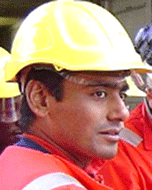Stochastic forecasting of production potential using customised type curves in coal seam gas*
Georg Zangl A , Shripad Biniwale B , Andreas Al-Kinani C , Vikram Sharma D and Rajesh Trivedi EA Schlumberger Information Solutions Level 5, 256 St. Georges Tce., Perth WA 6000. Email: gzangl@slb.com
B Schlumberger Information Solutions Level 5, 256 St. Georges Tce., Perth WA 6000. Email: sbiniwale@slb.com
C Schlumberger Information Solutions Muehlgasse 56, Baden, A-2500, Austria. Email: aal-kinani@slb.com
D Schlumberger Information Solutions Level 4, 256 St. Georges Tce., Perth WA 6000. Email: vsharma4@slb.com
E Schlumberger Information Solutions Level 5, 256 St. Georges Tce., Perth WA 6000. Email: rtrived@slb.com
The APPEA Journal 50(2) 718-718 https://doi.org/10.1071/AJ09082
Published: 2010
Abstract
This paper discusses a new workflow to stochastically estimate the performance of future production in coal seam gas (CSG) developments. Usually performance evaluations for CSG wells are conducted using either much-generalised statistical methods or numerical simulation. Both approaches have significant drawbacks; the former methods are quick but very often lack accuracy, while the latter is very accurate however also usually highly complex in set-up and computation.
The presented workflow is a new approach to well performance prediction that combines speed and reasonable accuracy. The workflow generates a set of key performance indicators of existing wells derived from historic dynamic data (water and gas production rates, pressures, etc.), static data (initial coal and reservoir properties, etc.) and predicted data (simplified production forecasts). The wells are then grouped according to the similarity of their KPIs. The production profiles of the wells within the same group are combined to a type curve that is described by the most likely production profile and an associated uncertainty range.
A data-driven expert system is used to identify and capture the correlations of the parameters such as geographic locations, well spacing, reservoir properties and the group membership (equivalent to type curve). This expert system can then be applied to any location in the field in order to determine the most likely group membership of a potential well. The classification of a new well to a group is hereby not necessarily unique; the expert system might classify a new well into several groups and assign a probability of occurrence for each of the groups. A Monte Carlo routine is then applied to forecast the performance of the new well locations honouring the respective probability of occurrence of each type curve.
Keywords: CSG, coal bed methane, stochastic, forecasting, type-curve, well performance, data mining, self-organising maps, key performance indicator, data quality, data screening, classification, Monte Carlo simulation

Georg Zangl holds an MSc degree in petroleum engineering of the Mining University in Leoben, Austria. With more than 18 years of experience, he has worked special purpose numerical and semi-analytical reservoir simulators, statistical and mathematical approaches to optimise production and on the architecture, design and implementation of digital oilfields. The results of his work in the field of data mining and production optimisation have been published in several international conferences and printed media. Georg was the founder and technical director of Decision-Team, which was acquired by Schlumberger in 2004. Since then, he has been the technical manager of Schlumberger Information Solutions in Austria. Just recently Georg has moved to Schlumberger Australia, where he holds the position of the production engineering manager. |

Shripad Biniwale is a senior petroleum engineer working with Schlumberger Australia, since 2005. Presently he is working as a production engineering team lead for Schlumberger Information Solutions in Perth where he works with production and reservoir engineering software. His present role involves providing technical solutions and workflow consulting to clients in production data management and engineering optimisation projects with Australian operating companies. He holds a masters of engineering in petroleum engineering and has more than 8 years of experience in research, engineering, software development, and project deployments. Shripad was involved with various projects in the areas of: oil spill contingency planning; reservoir characterisation; production data management; production optimisation; and, production engineering workflow solutions. Some of the key clients he has worked with are: Chevron Australia; Santos; Woodside; BHP; Origin Energy; Arrow Energy; Nexus; Apache; ENI; and, DMP. |

Andreas Al-Kinani holds an MSc degree in petroleum engineering of the Mining University in Leoben, Austria. Andreas has been working as petroleum engineer with Schlumberger Information Solutions (SIS) since 2004. He has been involved in numerous studies covering the whole petroleum system from the reservoir through the well head to the facilities and sales point. In his projects Andreas has integrated data mining approaches with analytical petroleum engineering techniques. He has implemented reservoir and production monitoring and workflow automation systems for multiple oil and gas companies worldwide. As an industry-wide recognised expert for the DECIDE! software suite Andreas is holding related trainings for petroleum engineers and supervising their work in data mining and workflow automation. |

Vikram Sharma holds an MSc degree in petroleum engineering of the Institut Français du Pétrole, Paris, France. Vikram has been working as a reservoir engineer with Schlumberger Information Solutions (SIS) since 2005. He has worked on several projects in Balikpapan and on reservoir engineering research topics in Aberdeen, UK. Some of them included the development of stochastic workflows in reservoir simulation. In 2008 Vikram joined Schlumberger Australia, where he works as a senior reservoir engineer and business development manager for Schlumbeger’s reservoir engineering products. Vikram has a high understanding of integrated solutions in production optimisation of conventional and unconventional hydrocarbon reserves. He is an expert in integrated asset modelling. |

Rajesh Trivedi is an information management specialist and has worked for Schlumberger Information Solutions in Adelaide and Perth since 2001. He holds a Master of Engineering in environmental engineering and has more than 18 years of experience in engineering, software development, and projects. His key area is projects-related data management and integration of production operation, reserves, economics, and information management system. He has been involved in many data management projects in and outside Australia. Some of the key projects he has worked are reserves data management system for: Santos; BHP; Woodside; Beach Petroleum; and, Chevron Bangkok. He has also worked on production data management projects for: Santos; Beach Petroleum; Nexus; AWE; PTTEP; and, Origin Energy. |
References
Arps, J.J. (1945). Analysis of decline curves. The American Institute of Mining, Metallurgical, and Petroleum Engineers. TRANS. 160, 228–47.Ghoraishy, S.M., Liang, J.T., Green, D.W., and Liang, H.C., 2008—Application of Bayesian Networks for Predicting the Performance of Gel-Treated Wells in the Arbuckle Formation, Kansas. SPE/DOE Improved Oil Recovery Symposium, Oklahoma, 19–23 April, SPE 113401.
Jensen, F., 2001—Bayesian Networks and Decision Graphs. In: Statistics for Engineering and Information Science. New York: Springer.
Korb, K., and Nicholson, A., 2004—Bayesian Artificial Intelligence. London: Chapman & Hall/CRC Press UK.
Mitchell, T., 1997—Machine Learning, International Edition. Singapore: McGraw-Hill.
Neapolitan, R., 2004—Learning Bayesian Networks. Upper Saddle River: Pearson Prentice Hall.
Zangl, G., and Hannerer, J., 2003—Data Mining—Applications in the Petroleum Industry. Texas: Round Oak Publishing.


